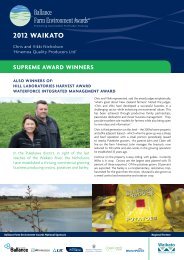Dairy's role in sustaining New Zealand - Fonterra
Dairy's role in sustaining New Zealand - Fonterra
Dairy's role in sustaining New Zealand - Fonterra
Create successful ePaper yourself
Turn your PDF publications into a flip-book with our unique Google optimized e-Paper software.
26 Dairy’s <strong>role</strong> <strong>in</strong> generat<strong>in</strong>g growth<br />
A.2 Dynamics of the MONASH-NZ model<br />
MONASH-NZ is a recursive dynamic CGE model based on the ORANI-NZ core. It can be<br />
thought of as a series of static simulations l<strong>in</strong>ked by three dynamic adjustment procedures.<br />
Each year’s simulation takes the f<strong>in</strong>al database of the previous year’s simulation as its start<strong>in</strong>g<br />
po<strong>in</strong>t and applies the current period’s shocks. Because the solution for the current period<br />
depends only on the previous period’s solution and the current period’s shocks, it can be<br />
solved recursively, rather than hav<strong>in</strong>g to solve all periods simultaneously. Economists might<br />
refer to this sort of model as hav<strong>in</strong>g adaptive, rather than rational, expectations formation.<br />
In addition to solv<strong>in</strong>g a ‘static’problem <strong>in</strong> each period, the MONASH-NZ model improves<br />
upon ORANI-NZ simulations by add<strong>in</strong>g three dynamic adjustment processes:<br />
• Labour market adjustment: We assume that wages are sticky <strong>in</strong> the short run and<br />
gradually adjust over time. A mechanism <strong>in</strong> the model allows employment to first<br />
respond to <strong>in</strong>creases <strong>in</strong> aggregate demand and then return to the NAIRU over time as<br />
wages adjust.<br />
• Capital formation: An <strong>in</strong>dustry-specific capital accumulation mechanism allows <strong>in</strong>dustries<br />
to build their stock of capital over time. Capital is generated by <strong>in</strong>vestment, which <strong>in</strong> turn<br />
responds to rates of return <strong>in</strong> each <strong>in</strong>dustry.<br />
• Balance of payments adjustment: The model tracks changes <strong>in</strong> the current account and<br />
capital account over time. Changes <strong>in</strong> net foreign liabilities affect domestic consumption<br />
through the level of <strong>in</strong>terest that must be paid to service the foreign debt.<br />
A.3 Database structure<br />
The model is based on a large database conta<strong>in</strong><strong>in</strong>g the value flows of the economy, as per<br />
Figure 11. The database def<strong>in</strong>es the <strong>in</strong>itial structure of the economy, which by def<strong>in</strong>ition is<br />
assumed to be <strong>in</strong> equilibrium <strong>in</strong> all markets. The structure of the database is broadly similar<br />
to traditional <strong>in</strong>put-output tables; for example commodities may be used as <strong>in</strong>termediate<br />
<strong>in</strong>put for further production, utilised <strong>in</strong> <strong>in</strong>vestment, exported or consumed by households<br />
and the government. Industry costs <strong>in</strong>clude the cost of <strong>in</strong>termediates, marg<strong>in</strong>s, taxes and<br />
primary factor costs for labour, land and capital. As per the account<strong>in</strong>g identities <strong>in</strong> <strong>in</strong>putoutput<br />
tables, the total value sum of producers’<strong>in</strong>put costs (<strong>in</strong>clud<strong>in</strong>g marg<strong>in</strong>s, taxes, returns<br />
to factors and other costs) equates to the total value of output production (the ‘MAKE’matrix<br />
<strong>in</strong> the database).<br />
The MONASH-NZ model consists of:<br />
• 131 <strong>in</strong>dustries<br />
• 210 commodities<br />
• 14 regions<br />
• 1 household<br />
• 24 occupations<br />
The database has been sourced <strong>in</strong>itially from Statistics <strong>New</strong> <strong>Zealand</strong> 1995/96 Inter-Industry<br />
tables, updated us<strong>in</strong>g the subsequently released 2003 Supply and Use tables, and f<strong>in</strong>ally ‘upscaled’to<br />
2007 levels us<strong>in</strong>g latest Statistics <strong>New</strong> <strong>Zealand</strong> macroeconomic data.
















